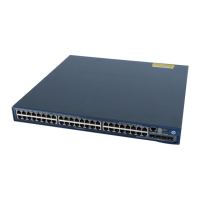32
Marker protocol
During a session, if member ports are added to or removed from a dynamic link aggregation group,
service traffic must be redistributed among all the new member ports of the link aggregation group. The
Marker protocol can be employed to quickly redistribute service traffic within link aggregation groups
and ensure the orderly transmission of data frames. The process is:
The device stops transmitting service traffic and starts a timer. No data frames will be transmitted on
the links until the timer expires.
The local end uses the Marker protocol to send a Marker Protocol Data Unit (PDU).
When a Marker Response Protocol Data Unit (PDU) is received from the peer or the timer expires,
the device starts to redistribute service traffic on all the new link aggregation member ports in the
Selected state.
NOTE:
The A5120 EI Switch Series supports returning Marker Response PDUs only after dynamic link
aggregation member ports receive Marker PDUs.
Link aggregation modes
Link aggregation has two modes: dynamic and static. Dynamic link aggregation uses LACP and static link
aggregation does not. Table 5 compares the two aggregation modes.
Table 5 A comparison between static and dynamic aggregation modes
LACP status on
member ports
Aggregation is stable. Peers do
not affect the aggregation state
of the member ports.
The member ports do not adjust
the aggregation state
according to that of the peer
ports. The administrator must
manually maintain link
aggregations.
The administrator does not need
to maintain link aggregations.
The peer systems maintain the
aggregation state of the member
ports automatically.
Aggregation is unstable. The
aggregation state of the
member ports is susceptible to
network changes.
The following points apply to a dynamic link aggregation group:
A Selected port can receive and send LACPDUs.
An Unselected port can receive and send LACPDUs only if it is up and has the same class-two
configurations as the aggregate interface.
Aggregating links in static mode
LACP is disabled on the member ports in a static aggregation group. You must manually maintain the
aggregation state of the member ports.
The static link aggregation procedure comprises:
Selecting a reference port
Setting the aggregation state of each member port

